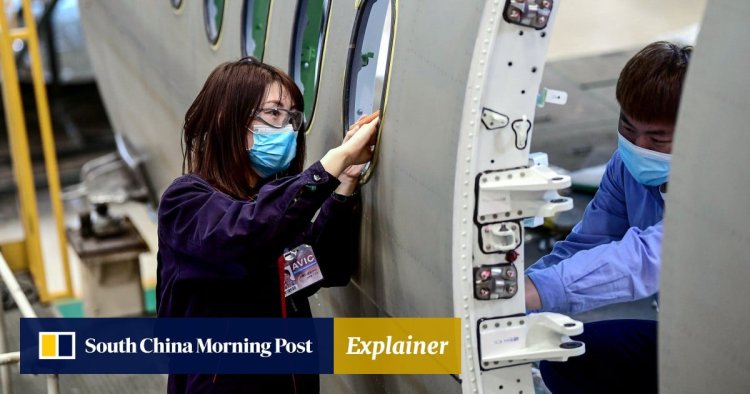Airbus, Boeing are vying for China’s aviation market, but does the European aerospace firm have the edge?
2023.04.16 22:00Airbus doubled down on its investment in China during a state visit by French President Emmanuel Macron, as the European aerospace firm seeks to widen its lead over rival Boeing in the critical aviation market.At the start of April on the sidelines of a meeting between President Xi Jinping and Macron, Airbus said it would double the capacity at its A320 family assembly plant in Tianjin and strengthen access to the world’s second-largest aviation market as domestic travel in China nears a return to pre-pandemic levels.Airbus has three other A320 family final assembly sites worldwide: Hamburg, Germany; Toulouse, France; and Mobile, US.China also agreed to buy 150 A320 and 10 A350-900 widebody commercial aircraft from Airbus.The announcements came amid worsening trade relations between China and the US that have essentially locked American aerospace manufacturer Boeing out of the world’s second-largest economy.Airbus expects huge growth in the Chinese aviation market in th


Airbus doubled down on its investment in China during a state visit by French President Emmanuel Macron, as the European aerospace firm seeks to widen its lead over rival Boeing in the critical aviation market.
At the start of April on the sidelines of a meeting between President Xi Jinping and Macron, Airbus said it would double the capacity at its A320 family assembly plant in Tianjin and strengthen access to the world’s second-largest aviation market as domestic travel in China nears a return to pre-pandemic levels.
Airbus has three other A320 family final assembly sites worldwide: Hamburg, Germany; Toulouse, France; and Mobile, US.
China also agreed to buy 150 A320 and 10 A350-900 widebody commercial aircraft from Airbus.
The announcements came amid worsening trade relations between China and the US that have essentially locked American aerospace manufacturer Boeing out of the world’s second-largest economy.
Airbus expects huge growth in the Chinese aviation market in the next 20 years. The European aerospace firm predicts that China’s air traffic will grow by 5.3 per cent annually, significantly faster than the world average of 3.6 per cent.
This will lead to a demand for 8,420 passenger and freighter aircraft by 2041, representing more than 20 per cent of the world’s total demand for around 39,500 new aircraft in the next 20 years.
Boeing has expressed a similar level of optimism, expecting China will require 8,485 new planes to serve passengers and trade until 2041.
Airbus counts China as a “strategic partner” and a key customer for its passenger jets and helicopters having first established an official presence in China in 1994.
Since 2008, Airbus has been assembling its narrow-body A320-family planes in the northern Chinese city of Tianjin.
It will now build a second assembly line at the Tianjin plant, which has so far assembled over 600 A320 family aircraft, according to Airbus. It launched its China research center on Friday in Suzhou to conduct research in manufacturing innovation, hydrogen infrastructure, passenger experience and new technologies.
‘Airbus, Boeing better buckle up’: China’s home-grown C919 could break duopoly
In March, Airbus delivered the first A321neo aircraft from the Tianjin assembly line.
In 2017, Airbus established a completion and delivery centre for the A330 in Tianjin, marking Airbus’ first widebody aircraft centre outside Europe.
Airbus has facilities in eight different locations in China for its helicopter-related activities, including a regional customer service centre and logistics platform at Hong Kong International Airport and a H135 final assembly line in Qingdao, Shandong province.
Airbus also has a 5 per cent stake in AviChina, a Hong Kong listed helicopter and regional aircraft maker which is owned by majority shareholder, the state-owned Aviation Industry Corporation of China (Avic).
Last year, Airbus and Tarmac Aerosave signed a memorandum of understanding with the city of Chengdu, the capital of southwestern Sichuan province, to develop a service centre to cover parking, storage, maintenance, upgrades, conversions, dismantling and recycling services for various types of planes.
Airbus has more than 1,900 employees working in China.
By the end of the first quarter in 2023, the Airbus in service fleet in China had risen to over 2,100 aircraft, representing more than 50 per cent of the market, it said.
Boeing has been competing with Airbus in China, but over the past few years, the US aerospace giant has struggled to sell its passenger jets amid deteriorating relations between Beijing and Washington, while Airbus has been gaining new orders.
Boeing’s 737 MAX had been grounded in China for nearly four years following two deadly crashes in Indonesia and Ethiopia and only just returned to service this year.
The US plane maker said in a social media post on its official WeChat account in April that the number of 737 MAX returning to commercial service had reached 43, accounting for around 45 per cent of the Chinese 737 MAX fleet.
Like Airbus, Boeing sees China as a critical market, employing more than 2,200 people within its subsidiaries and joint ventures.
Orders fly in for C919 passenger jet at China’s biggest air show
Boeing’s investment in China contributes around US$1.5 billion annually to China’s economy, Boeing said, having delivered more than 2,000 aeroplanes to Chinese airlines and leasing companies, making China the biggest civil aviation market outside the US.
However, Boeing only began to deliver its 737 out of its assembly line in Zhoushan, a joint venture with China’s Commercial Aircraft Corporation of China (Comac) in 2018, nearly a decade after Airbus.
Boeing also has a joint venture with Avic in Tianjin to produce aerospace composite parts and assemblies, including primary structures, secondary structures and interior components for its passenger jets.
Aviation trade has been increasingly influenced by bilateral relations over the past few years.
Washington has grown wary of Beijing’s civil military fusion strategy, which aims to ensure military and economic development advances in lockstep with scientific and technological innovation.
Many aviation products are known to be dual use – meaning they have both commercial and military applications – and are therefore subject to US exports controls.
In 2021, Avic and some of its subsidiaries were identified as military end users by the US government, and American investors were banned from investing.
Avic was an active investor in the US aviation sector and formed a number of joint ventures with US companies, such as GE Aviation.
Europe currently does not have similar regulations against Avic or its subordinate companies.
What is China’s C919 passenger jet and can it take on Airbus, Boeing?
However, US Trade Representative Katherine Tai has said the US plans to cooperate with the European Union on confronting China’s “non-market” practices in the aerospace industry.
In 2021, the US and the European Union agreed to a truce in their near 17-year conflict over aircraft subsidies to Boeing and Airbus, a move that was seen as a joint effort to target China as it seeks to carve out a share in the global commercial aircraft market.
While Airbus appears to have an edge over Boeing when it comes to growing its business in China, it is likely to face competition from China’s home-grown C919.
The narrow-body passenger jet made by Comac is designed to compete with both Boeing’s 737 and Airbus’ A320.
The C919 received certification last year and is expected to go into commercial service in 2023.
China has made clear it wants to reduce reliance on imports and has invested heavily to develop its capability to manufacture commercial jets as well as engines.
What's Your Reaction?

















